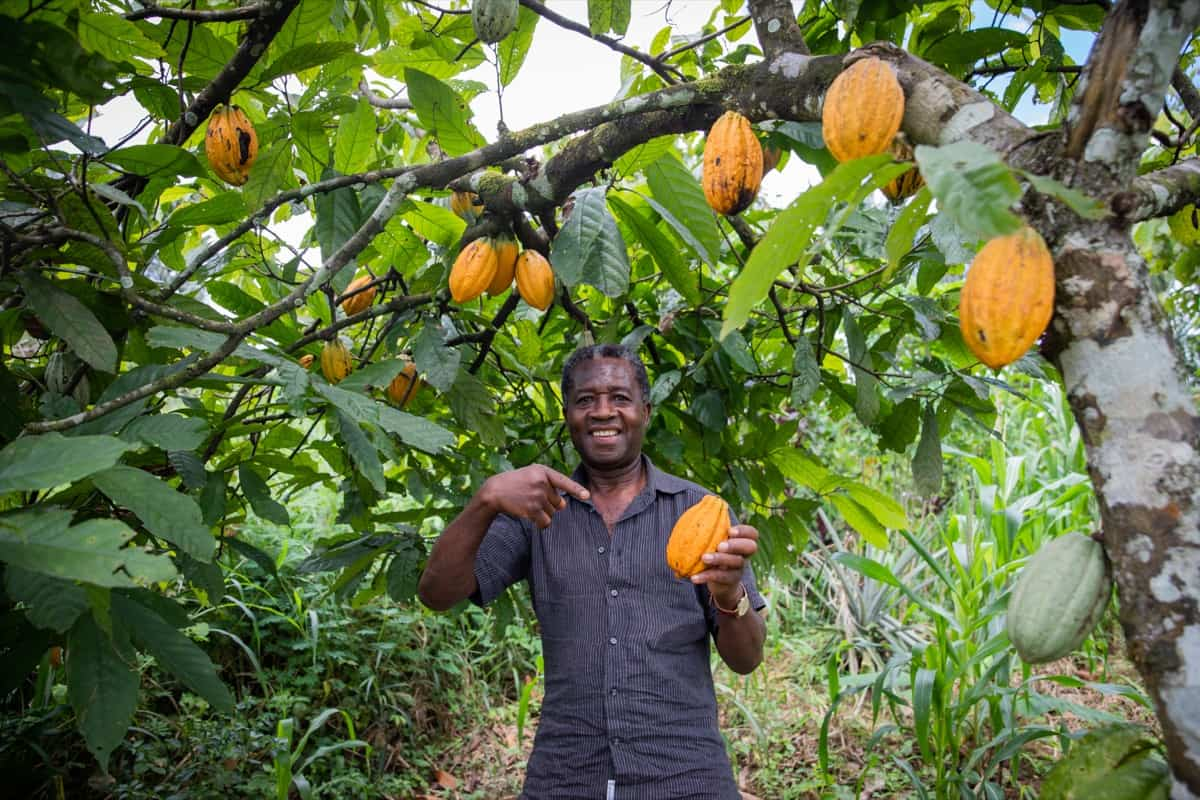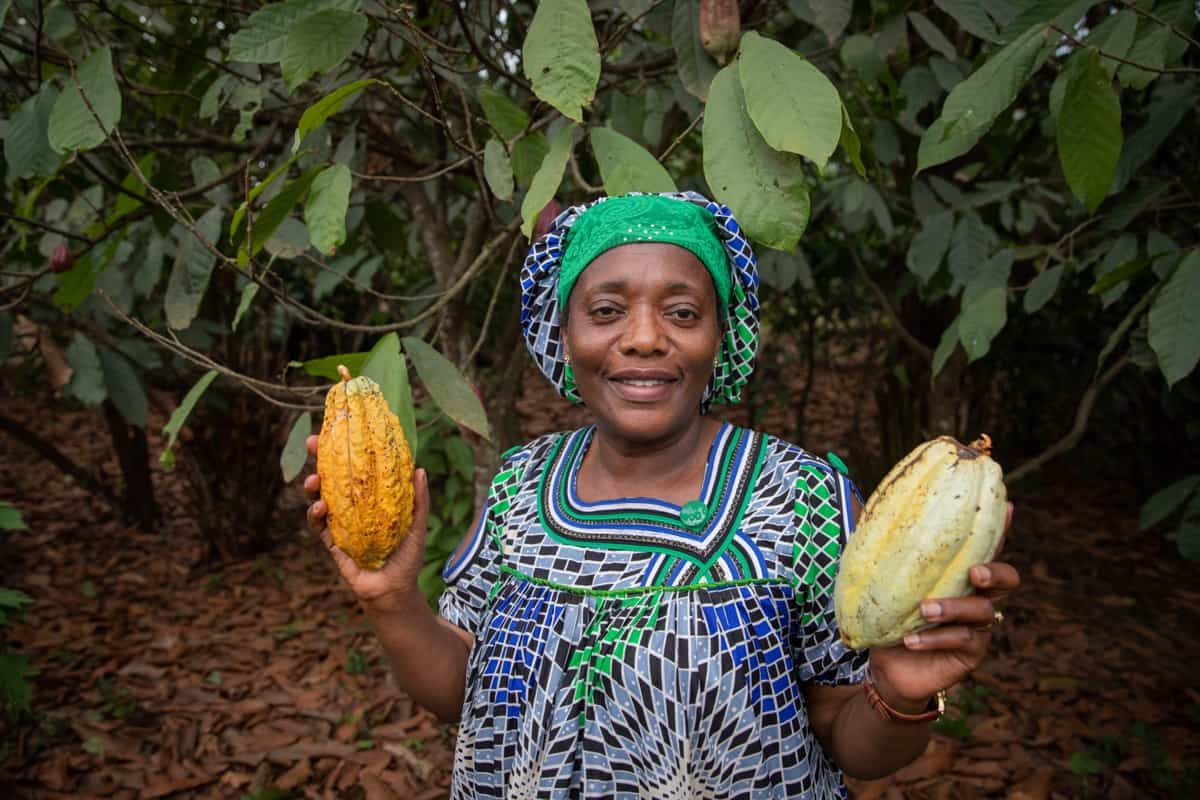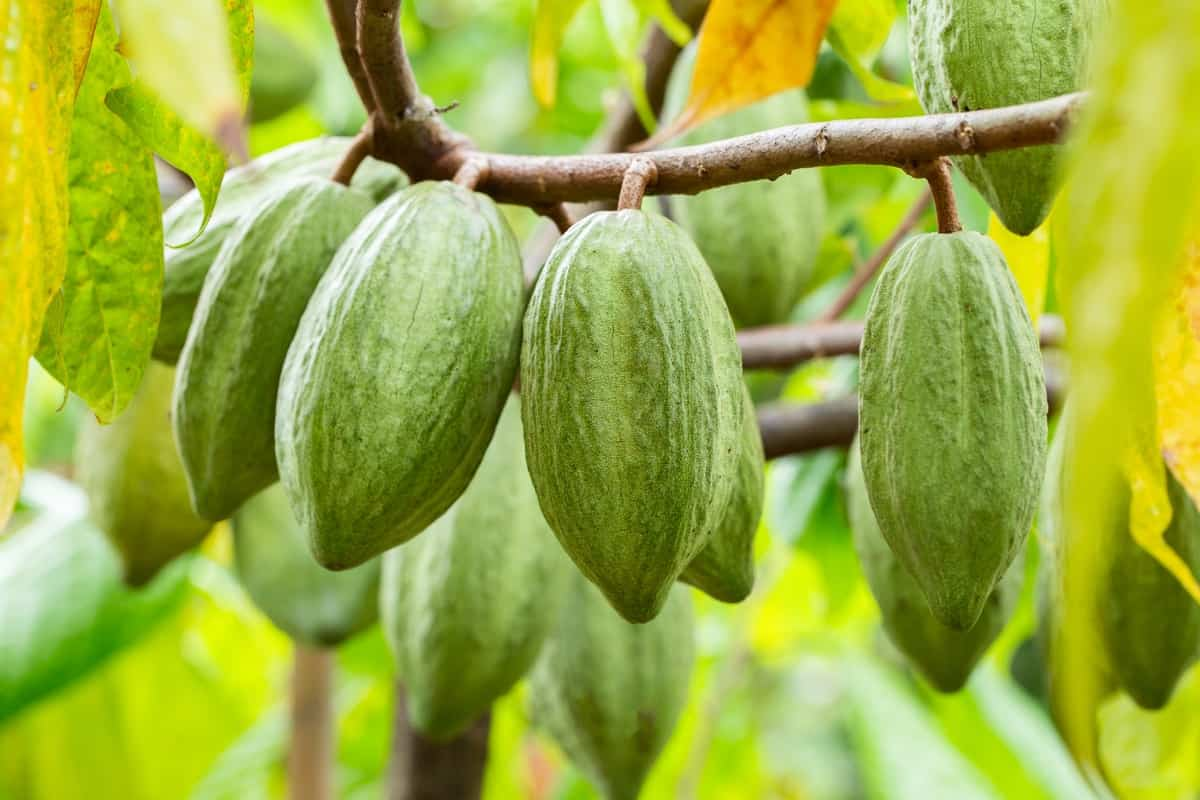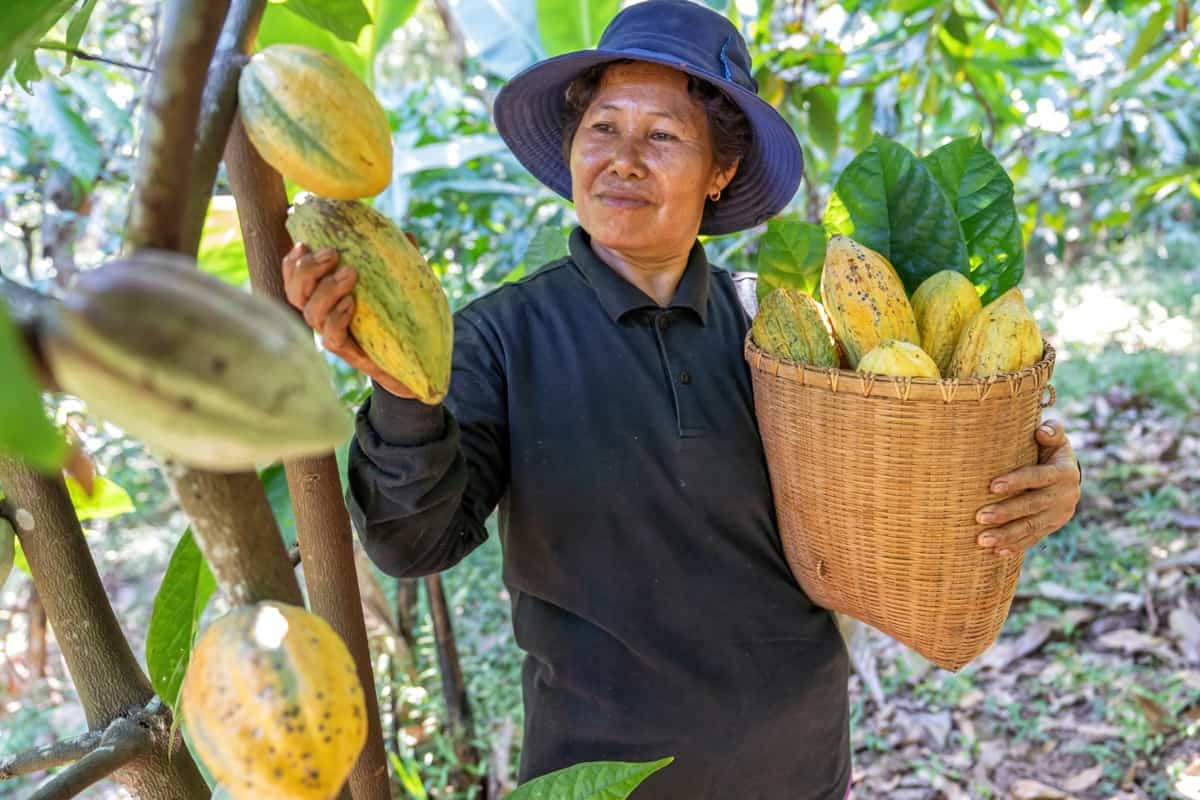Welcome to our comprehensive guide on cacao farming in Ghana! In this blog post, we will delve into the fascinating world of cacao cultivation, exploring the different varieties, requirements, and techniques involved. Ghana, known as the “Cocoa Capital of the World,” boasts a rich history and tradition in cacao production.

We will provide accurate data, summarizing each sentence to ensure clarity and ease of understanding. Join us as we uncover the secrets behind successful cacao farming in Ghana, empowering you to embark on your cocoa-growing adventure.
What is Cacao Farming in Ghana?
Cacao farming in Ghana refers to cultivating cacao trees, primarily for producing cocoa beans. Ghana is renowned as one of the world’s leading cacao producers, making it an integral part of the country’s agricultural landscape. The cocoa beans grown in Ghana are highly sought after due to their rich flavor and high quality. Cocoa farming is vital to Ghana’s agricultural sector, serving as its primary cash crop and chief export.
Ghana ranks second globally in cocoa exports, closely following Ivory Coast. The country’s cocoa production is highly regarded in the developing world, recognized for its exemplary practices and economic value. Cultivation primarily occurs in forested regions, including Ashanti, Brong-Ahafo, Central, Eastern, Western, and Volta, where annual rainfall ranges between 1,000 and 1,500 millimeters. The crop year commences in October, with the main crop purchase, followed by a smaller mid-crop cycle in July.
The Cocoa Marketing Board ensures that all cocoa, except illicitly smuggled produce, is sold at fixed prices. Although most cocoa production occurs on small plots of land, a select group of farmers holds significant influence in the industry. Studies indicate that a quarter of cocoa farmers earn over half of the total cocoa income. In terms of governance, the government has privatized crop transport, eliminated subsidies for production inputs, and initiated joint ventures in the processing sector.
Notable reforms include introducing the Akuafo Check System and streamlining payment processes for farmers. Despite facing setbacks such as aging trees, diseases, adverse weather conditions, and low producer prices, cocoa production in Ghana experienced a recovery, with a projected return to the 300,000-ton range. Ghana Cocoa Board (Cocobod) played a crucial role in liberalizing and privatizing cocoa marketing, offering higher prices to producers, and implementing incentives for private traders.
In case you missed it: The Sustainable Solution: Bio-composting with Agricultural By-products

The government also focused on rejuvenating cocoa production by providing seedlings to replace lost trees, expanding the cultivation area, improving transportation infrastructure, enhancing productivity, and investing in research and extension services. These initiatives contributed to the steady rise in cocoa production from the 1990s.
Climate Requirements for Cacao Cultivation in Ghana
Cacao cultivation in Ghana is heavily influenced by its climate requirements. The crop thrives in regions characterized by specific climatic conditions. Ghana’s cocoa-growing areas, such as Ashanti, Brong-Ahafo, Central, Eastern, Western, and Volta regions, receive an average annual rainfall ranging from 1,000 to 1,500 millimeters. This moderate to high rainfall is vital for the successful growth and development of cacao trees. The country’s climate is also characterized by distinct wet and dry seasons. The wet season, typically from April to September, provides the necessary moisture for optimal cocoa production.
In contrast, the dry season, spanning October to March, allows for the ripening and harvesting of cocoa pods. Moreover, cacao cultivation thrives in areas between 21°C and 32°C. These temperature ranges facilitate the proper development of the fruiting stage and overall growth of cacao trees.
Cacao Farming Techniques in Ghana
Cacao farming techniques in Ghana have evolved, incorporating scientific knowledge to improve productivity and quality. Some of the best techniques employed by farmers include proper variety selection, shade management, improved planting practices, soil fertility management, disease and pest control, pruning and training, water management, integrated pest management (IPM), harvesting and post-harvest practices, and continuous learning and adaptation.
In case you missed it: How to Treat Sweet Potato Pests and Diseases: Management, Control, and Prevention

These techniques help protect cacao trees from excessive sunlight, provide habitat for beneficial organisms, and ensure proper growth and airflow. Farmers also use proper irrigation techniques, such as drip or mulching, to maintain consistent moisture levels and prevent water stress. Integrated pest management (IPM) strategies combine biological control, cultural practices, and selective pesticide use to minimize environmental impact. Harvesting and post-harvest practices involve proper fermentation and drying techniques, contributing to flavor development and quality.
Sustainable Cacao Farming Practices in Ghana
Sustainable cacao farming practices in Ghana prioritize environmental conservation, social responsibility, and economic viability. Key stages of cacao farming include clearing land, conducting soil tests, planting variety selection, maintaining a balanced shade canopy, intercropping, organic matter incorporation, covering crops, pest and disease control, balanced nutrient application, and organic fertilizers.
These practices help ensure optimal growth and productivity, biodiversity, and long-term storage of cacao beans. In Ghana, balanced soil test results are used to determine nutrient levels and acidity, allowing farmers to make informed decisions about soil management. Variety selection ensures optimal growth and productivity, while shade management promotes biodiversity and protects against extreme weather.
Intercropping and organic matter incorporation improve soil fertility, moisture retention, and microbial activity. Biological control encourages natural predators, while fertilization ensures essential nutrients are provided to cacao plants. Harvesting ensures optimal flavor and quality, and post-harvest processing preserves the unique flavors of cacao beans for long-term storage.
Cacao Varieties Grown in Ghana
Ghana is known for its diverse cacao varieties, each contributing unique flavors and characteristics to its cocoa production. Some prominent varieties include Amelonado, Criollo, Trinitario, Forastero, Forastero, Nacional, and Forastero. Amelonado is the most common and traditional variety, known for its rich and robust flavor profile. Criollo is a premium variety with delicate and complex flavors, often described as fruity and floral.
Trinitario is a hybrid, combining the best qualities of both parent varieties. Forastero is a hardier and more disease-resistant variety, typically grown in Ghana, with larger beans and a robust flavor profile. Nacional, a less prevalent variety, is known for its unique floral and fruity flavor notes, contributing to the complexity of Ghanaian cocoa.
In case you missed it: How to Start Shrimp Farming in South Africa: Requirements, Key Rules, Management, Cost, Subsidy, and Loans

Cacao Diseases and Pest Management in Ghana
Cacao farming in Ghana faces various diseases and pests that can significantly impact crop health and productivity. Common diseases include Black Pod Disease, Frosty Pod Rot, Swollen Shoot Disease, Capsids, Cocoa Mirids, Cocoa Pod Borer, and Vascular-Streak Dieback. These diseases require timely pruning, removal, destruction, and use of fungicides. Control strategies include proper sanitation, pruning, and application of fungicides.
Cocoa swollen shoot virus (CSSV) stunts tree growth and infected trees must be uprooted and destroyed to prevent further spread. Integrated pest management techniques, including pheromone traps and insecticides, control these pests. Additionally, addressing Phytophthora spp.-associated Vascular-Streak Dieback involves sanitation, pruning, and using resistant varieties to protect cacao trees from these diseases.
Cacao Farm Management in Ghana
Cacao farm management in Ghana is crucial for maximizing productivity and sustainable cocoa production. Key aspects include disease and pest control, fertilizer application, pruning, shade management, irrigation, weed control, harvesting, and post-harvest processing. Pest control includes monitoring, cultural practices, biological control, and judicious use of pesticides. Fertilizer application ensures nutrient levels are balanced, promoting healthy tree growth and higher yields.
Pruning removes diseased or unproductive branches, improves airflow, and facilitates sunlight penetration. Irrigation ensures adequate water supply during dry periods, while weed control minimizes competition for nutrients, water, and sunlight. Harvesting ripe cacao pods at the right maturity stage and following proper post-harvest processing procedures preserve bean quality and flavor.
Cacao Agroforestry Systems in Ghana
Cacao agroforestry systems in Ghana involve integrating cocoa cultivation with other trees and crops to promote ecological sustainability and enhance farmer livelihoods. They provide shade for cocoa trees, protecting them from extreme weather and improving cocoa quality. Additionally, the diversity of trees and crops in agroforestry systems supports biodiversity, provides habitats for beneficial insects and birds, and improves soil health.
Farmers can also diversify their income by harvesting additional crops like plantains or timber trees alongside cocoa. Agroforestry systems contribute to climate change mitigation by sequestering carbon dioxide and reducing greenhouse gas emissions. They also offer resilience against pests and diseases, as the diversity of plants reduces the risk of widespread crop damage.
Organic Cacao Farming Methods in Ghana
Organic farming focuses on soil health through composting, cover cropping, and organic matter incorporation. Pest and disease control methods, beneficial insects, are employed without synthetic chemicals. Fertilization is based on natural sources like compost, animal manure, and organic-approved fertilizers.
Weed management, such as manual weeding and mulching, promotes a healthy cocoa ecosystem. Shade management, including native tree-based canopy, enhances biodiversity and protects plants from extreme weather. Post-harvest processing follows organic principles without additives or synthetic chemicals.
Market Opportunities for Cacao Farmers in Ghana
The global demand for cocoa products continues to rise, creating a favorable environment for Ghanaian farmers. The country’s reputation as a top-quality cocoa producer opens doors for exports to various international markets. Additionally, there is growing interest in sustainably sourced and ethically produced cocoa, allowing Ghanaian farmers to tap into premium markets. The government and industry stakeholders actively promote value addition and processing within the country, enabling farmers to participate in the entire cocoa value chain.
In case you missed it: Crop Residue Management: A Sustainable Approach for Agricultural Success

Cacao Harvesting and Post-harvest Processing in Ghana
- After harvesting, cocoa pods in Ghana are typically collected every 3-4 weeks during the main crop season (October-March) and the mid-crop season (May-August). Farmers use knives or sickle-shaped knives on long poles to harvest the pods without damaging the tree.
- Diseased and damaged pods are removed, while healthy pods are taken to a central breaking point. Pod breaking is done within 2-3 days after harvest, and the beans are scooped out by hand, discarding the husk and placenta.
- The beans, embedded in a sweet, white mucilaginous pulp, undergo fermentation, which begins on the same day as pod breaking. Fermentation is a spontaneous process in two stages: anaerobic and aerobic. It involves microbial succession with yeasts, lactic acid bacteria, and acetobacter.
- Fermentation takes about six days, resulting in the development of chocolate precursors in the pulp. Following fermentation, the beans are dried for about seven days under the sun.
- Proper drying ensures the reduction of moisture content from approximately 55% to 7%, resulting in well-fermented and well-dried brown beans.
- Care must be taken during the entire process, from harvest to drying, to maintain optimum quality and avoid contamination. The dried beans are then cleaned, packed into jute bags, and stored in well-ventilated rooms with low humidity to maintain quality. With a moisture content of 7%, cocoa beans can be stored for many years under ideal conditions.
Cacao Certification Programs in Ghana
Cacao certification programs in Ghana promote sustainable and ethical practices in the cocoa industry, improving farmer livelihoods, protecting the environment, and ensuring high-quality cocoa production. Programs like Fairtrade, Rainforest Alliance, and UTZ provide guidelines and standards for farmers, covering fair prices, social welfare, environmental conservation, and responsible farming practices. Certified farmers receive premium prices, training, resources, and market access.
Challenges Faced by Cacao Farmers in Ghana
Cacao farmers in Ghana face numerous challenges that impact their livelihoods and industry sustainability. These include low productivity due to aging trees, diseases, and inadequate access to resources like fertilizers and planting materials. Climate change affects cocoa growth and increases the risk of pests and diseases.
Price volatility leads to income instability, limited access to finance, infrastructure, pests, and diseases, an aging farmer population, and limited market information. Farmers struggle to plan and invest in their farms, resulting in income instability and potential threats to the industry’s future.
Cacao Export Regulations in Ghana
Cacao export regulations in Ghana are in place to ensure the quality and control of cocoa exports from the country. The Ghana Cocoa Board (COCOBOD) is responsible for overseeing and regulating the export of cocoa. To export cocoa, exporters must obtain a license from COCOBOD and comply with their guidelines. These guidelines cover quality standards, grading, packaging, and documentation requirements.
In case you missed it: Polyhouse Farming in India: Training, Cost, Equipment, Subsidy, and Techniques

Impact of Climate Change on Cacao Farming in Ghana
Climate change poses significant challenges to Ghanaian cacao farming, affecting sustainability and productivity. Rising temperatures, changing rainfall patterns, and pests and diseases disrupt growth, reducing yields and lower bean quality. Farmers and stakeholders must adopt climate-smart practices like shade management, irrigation techniques, and disease-resistant varieties to ensure long-term viability. These changes threaten cocoa crops and require farmers and stakeholders to adapt to these challenges.
Conclusion
Cacao farming in Ghana offers a promising opportunity for sustainable agricultural practices. Farmers can cultivate high-quality cocoa and contribute to the country’s thriving cocoa industry by selecting appropriate varieties, implementing proper requirements, and employing effective techniques.
- How to Build a Low-budget Goat Shed: Cheap Ideas and Tips
- Goat Farming Training Programs in India: A Beginner’s Guide
- Types of Pesticides Used in Agriculture: A Beginner’s Guide
- Economical Aquaculture: A Guide to Low-Budget Fish Farming
- 15 Common Planting Errors That Can Doom Your Fruit Trees
- How to Make Houseplants Bushy: Effective Tips and Ideas
- Innovative Strategies for Boosting Coconut Pollination and Yield
- Pollination Strategies for Maximum Pumpkin Yield
- The Complete Guide to Chicken Fattening: Strategies for Maximum Growth
- Natural Solutions for Tulip Problems: 100% Effective Remedies for Leaf and Bulb-Related Issues
- Revolutionizing Citrus Preservation: Towards a Healthier, Greener Future
- Natural Solutions for Peony Leaf and Flower Problems: 100% Effective Remedies
- Maximizing Profits with Avocado Contract Farming in India: A Comprehensive Guide
- Natural Solutions for Hydrangea Problems: 100% Effective Remedies for Leaf and Flowers
- The Ultimate Guide to Choosing the Perfect Foliage Friend: Bringing Life Indoors
- From Sunlight to Sustainability: 15 Ways to Use Solar Technology in Agriculture
- The Ultimate Guide to Dong Tao Chicken: Exploring from History to Raising
- The Eco-Friendly Makeover: How to Convert Your Unused Swimming Pool into a Fish Pond
- Mastering the Art of Delaware Chicken Farming: Essentials for Healthy Backyard Flocks
- 20 Best Homemade Fertilizers for Money Plant: DIY Recipes and Application Methods
- How to Craft a Comprehensive Free-Range Chicken Farming Business Plan
- Brighten Your Flock: Raising Easter Egger Chickens for Beauty and Bounty
- How to Optimize Your Poultry Egg Farm Business Plan with These Strategies
- Subsidy for Spirulina Cultivation: How Indian Government Schemes Encouraging Spirulina Farmers
- Ultimate Guide to Raising Dominique Chickens: Breeding, Feeding, Egg-Production, and Care
- Mastering the Art of Raising Jersey Giant Chickens: Care, Feeding, and More
- Ultimate Guide to Raising Legbar Chickens: Breeding, Farming Practices, Diet, Egg-Production
- How to Raise Welsummer Chickens: A Comprehensive Guide for Beginners
- How to Protect Indoor Plants in Winter: A Comprehensive Guide
- Ultimate Guide to Grow Bag Gardening: Tips, Tricks, and Planting Ideas for Urban Gardeners
- Guide to Lotus Cultivation: How to Propagate, Plant, Grow, Care, Cost, and Profit
- Agriculture Drone Subsidy Scheme: Government Kisan Subsidy, License, and How to Apply Online
- Ultimate Guide to Raising Araucana Chickens: Breed Profile, Farming Economics, Diet, and Care
- Bringing Hydroponics to Classroom: Importance, Benefits of Learning for School Students
- Ultimate Guide to Raising Polish Chickens: Breed Profile, Farming Economics, Diet, and Care
- Ultimate Guide to Raising Australorp Chickens: Profile, Farming Economics, Egg Production, Diet, and Care